Three Colors: Blue 4K Blu-ray Movie
HomeThree Colors: Blue 4K Blu-ray Movie 
Trois couleurs: Bleu / 4K Ultra HD + Blu-rayCriterion | 1993 | 99 min | Rated R | No Release Date
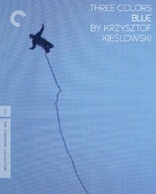
Price
Movie rating
8.3 | / 10 |
Blu-ray rating
| Users | 0.0 | |
| Reviewer | 4.0 | |
| Overall | 4.0 |
Overview
Three Colors: Blue 4K (1993)
Julie is the lone survivor of an automobile crash that killed her husband, a famed composer, and their only child. Despondent, Julie attempts suicide, but she cannot bring herself to take her own life. Instead, she sets about starting over, purging all remnants of her former existence in an attempt to sever her ties to the past.
Starring: Juliette Binoche, Benoît Régent, Florence Pernel, Charlotte Véry, Hélène VincentDirector: Krzysztof Kieślowski
| Drama | 100% |
| Foreign | 81% |
| Mystery | 14% |
| Music | 7% |
Specifications
Video
Video codec: HEVC / H.265
Video resolution: 4K (2160p)
Aspect ratio: 1.85:1
Original aspect ratio: 1.85:1
Audio
French: DTS-HD Master Audio 5.1 (48kHz, 24-bit)
French: DTS-HD Master Audio 2.0
Subtitles
English
Discs
Blu-ray Disc
Two-disc set (2 BDs)
4K Ultra HD
Playback
Region A (locked)
Review
Rating summary
| Movie | 5.0 | |
| Video | 4.0 | |
| Audio | 5.0 | |
| Extras | 5.0 | |
| Overall | 4.0 |
Three Colors: Blue 4K Blu-ray Movie Review
Reviewed by Dr. Svet Atanasov February 4, 2023Krzysztof Kieślowski's "Blue" (1993) arrives on 4K Blu-ray/Blu-ray courtesy of Criterion. The supplemental features on the release include archival program with Juliette Binoche; archival program with composer Zbigniew Preisner; two student films directed by Krzysztof Kieślowski; vintage trailer for the film; and more. In French, with optional English subtitles for the main feature. Region-Free.

During a horrific car accident somewhere in the French countryside, Julie (Juliette Binoche) loses her husband, an acclaimed European composer, and young daughter. She is found unconscious and quickly transported to a Parisian hospital. In the days after the accident, her wounds begin to heal but her soul hurts so bad that she attempts to commit suicide -- and fails.
Immediately after she is released from the hospital, Julie begins erasing her past. First, she sells her house, then she burns the scores of her husband's unfinished composition. She also makes love to one of his best friends (Benoit Regent) -- to make sure that she is still alive and has retained the ability to feel -- and rents a small apartment in downtown Paris. Around the same time, she is approached by one of her neighbors (Charlotte Very), a single young woman making ends meet in a sex club on Place Pigalle, who wants to be friends with her.
In the months after the accident Julie begins to forget. Her mind and heart insist that she spends all of her time alone, but occasionally she visits a nearby cafe and listens to the sounds of the world moving around her. After one of these trips to the cafe, her neighbor phones and asks for help. At the club, where the two meet, while looking at a TV monitor running a report about her husband's unfinished composition, she accidentally discovers that he had a mistress (Florence Pernel).
A few days later, Julie and her husband's mistress meet and quickly conclude that both were genuinely loved by the same man. They also concede that their lives have been permanently scarred, but because of their loss, both have learned to appreciate them even more. After the two part ways, Julie finally regains her freedom.
The first of the three films in Krzysztof Kieślowski's brilliant Three Colors trilogy, Blue, captures the essence of loss like no other contemporary film does. The focus of attention, however, is not on its dramatic and often destructive effects, but on the transition period where one slowly moves away from it.
The film is quiet, elegant, and often indescribably beautiful, but incredibly cruel as well. However, despite its tremendous intensity, it is completely free of melodrama. Julie does everything a devastated person would and gradually comes to realize that the man she loved and lost was a stranger. It is a disappointing, painful realization but a liberating one as well.
Blue, one of the three colors of the French national flag, has a prominent role throughout the entire film as it is directly linked to Julie's efforts to regain her liberty. (Liberté, égalité, fraternité is the national motto of France). However, the film does not attempt to define or politicize liberty. It simply suggests that liberty is elusive, perhaps even mythical.
Three Colors: Blue 4K Blu-ray Movie, Video Quality 
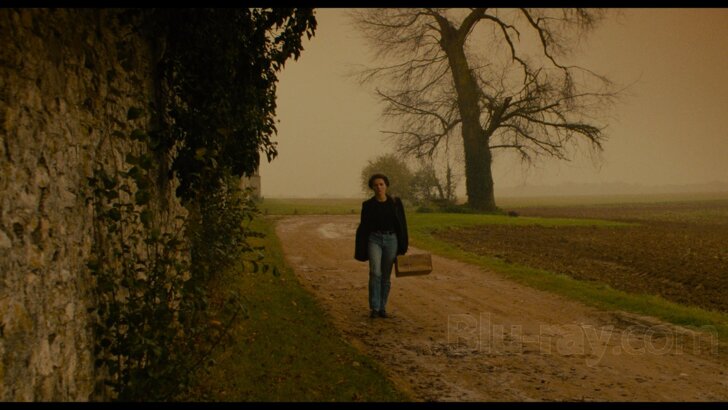
Criterion's release of Blue is a 4K Blu-ray/Blu-ray combo pack. It is included in the Three Colors 4K Blu-ray/Blu-ray box set. The 4K Blu-ray is Region-Free. The Blu-ray is Region-A "locked".
UPDATE: I have received a market copy of the 4K Blu-ray/Blu-ray box set. The Blu-ray disc presents the older version of Blue, from the original three-disc Blu-ray box set, with the older color timing. I have provided some additional screencaptures from the Blu-ray disc that is included in this box set.
The following text appears inside the booklet that is provided with this release:
"The new 4K restorations of all three films (Blue, White, Red) were undertaken by MK2 at Hiventy in Joinville-le-Pont, France, using the 35mm original camera negatives. The restoration of Blue was supervised by director of photography Slawomir Idziak; the restoration of Red was supervised by cinematographers Piotr Sobocinski Jr. and Michael Sobocinski, sons of director of photography Piotr Sobocinski; and an archival 35mm theatrical print was used as a color reference for White. The 5.1 surround soundtracks were created from the 35mm magnetic tracks."
Please note that some of the screencaptures in this article are taken from the 4K Blu-ray and downscaled to 1080p. Therefore, they do not accurately reflect the quality of the 4K content on the 4K Blu-ray disc, including the actual color values of this content.
Screencaptures #1-31 are from the 4K Blu-ray disc of Blue.
Screencaptures #33-40 are from the Blu-ray disc of Blue.
Criterion released the Three Colors trilogy on Blu-ray more than a decade ago, in 2011. Each release was sourced from masters that were prepared even earlier. The three films were recently redone in 4K and this box set introduces the new 4K makeovers in native 4K. The 4K presentations can be viewed with HDR and Dolby Vision. I viewed Blue with Dolby Vision.
The new 4K makeover produces healthier visuals that routinely boast better delineation, clarity, and depth. I would not describe the overall difference in quality as dramatic because the 1080p presentation of Blue from the previous Blu-ray release still looks very nice, but the improved density and dynamic range of the visuals in native 4K are undeniable. However, these discrepancies should not be surprising. They should be expected because they are two of the key areas where proper 4K presentations must excel. Fluidity is improved too, so if you view your films on a large screen or project, now you should notice much more even visuals. Unfortunately, the color balance of the new 4K makeover is unconvincing. Why? The color blue has always had a very prominent role in this film but now it is diminished and the difference is very obvious. Indeed, in the past, the film has always had different ranges of blues directly linked to Julie's efforts to regain her liberty, but on the new 4K makeover there are various ranges of turquoise (and some cyan). There is only one sequence where much of the blue is retained but with different saturation levels. (It is the pool sequence, which would have been very difficult to dramatically destabilize because in the past the blue was most prominent there). While in some areas the turquoise could blend rather nicely with certain primary colors, if you have previous experience with the film, you will instantly recognize that the original blue is either dramatically toned down or lost. Sadly, in most cases, the blue is replaced with turquoise. So, is this a serious problem? As far as I am concerned, the answer is yes. I have seen the film theatrically multiple times and can categorically state that the amount of prominent turquoise that is present on the 4K makeover has been introduced in a lab. I am sorry, but current claims floating around the internet that this is the intended look of the film are false. The film's original theatrical appearance emphasizes blues -- sometimes very thick blues, like the ones that are present during the pool sequence, and sometimes unique 'flashes' of blues, like the ones missing in screencaptures #30 and 31 -- and does it very effectively in many memorable ways. Image stability is outstanding. The entire film looks immaculate as well.
Three Colors: Blue 4K Blu-ray Movie, Audio Quality 
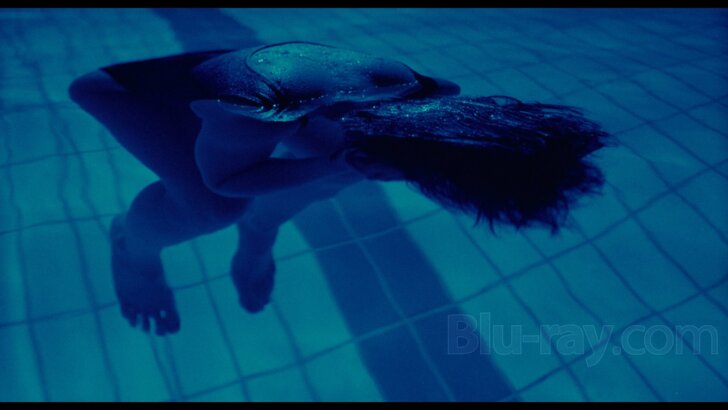
There is only one standard audio track on the 4K Blu-ray release: French DTS-HD Master Audio 5.1. Optional English subtitles are provided for the main feature. The Blu-ray disc has two standard audio tracks: French DTS-HD Master Audio 2.0 and French DTS-HD Master Audio 5.1.
The quality of the audio is outstanding. Depth, clarity, separation, and the unique contrasts that are associated with Zbigniew Preisner's score create quite the sound field. I did not encounter any encoding anomalies to report in our review.
Three Colors: Blue 4K Blu-ray Movie, Special Features and Extras 
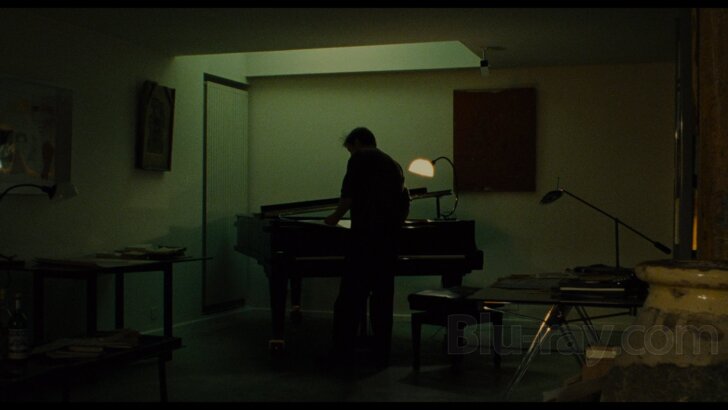
4K BLU-RAY DISC
- Bonus Features - there are no bonus features on the 4K Blu-ray disc.
- Trailer - the original theatrical trailer for Blue. In French, with optional English subtitles. (2 min, 1080p).
- On Blue - a video essay written and narrated by film studies professor Annette Insdorf, author of Double Lives, Second Chances: The Cinema Krzysztof Kieslowski. With clips and stills from the Polish director's films. In English, not subtitled. (21 min, 1080p).
- Kieslowski's Cinema Lesson - in this segment from 1994, Krzysztof Kieslowski discusses the significance of a specific sequence from Blue, as well as the importance of the sugar cube scene in the Parisian cafe. In Polish, with imposed French subtitles and optional English subtitles. (8 min, 1080i).
- Juliette Binoche - the French actress comments on specific scenes from the film. (The comments are part of an audio commentary recorded in 2004). In French, with optional English subtitles. (25 min, 1080i).
- Zbigniew Preisner - archival nterview with composer Zbigniew Preisner, who recalls his collaboration with Krzysztof Kieslowski on the Three Colors trilogy, No End, The Decalogue, and The Double Life of Veronique. The interview was recorded exclusively for Criterion in 2011. In Polish, with optional English subtitles. (22 min, 1080p).
- Reflections on "Blue" - film critic Geoff Andrew, actor Juliette Binoche, filmmaker Agnieszka Holland, cinematographer Slawomir Idziak, professor Annette Insdorf, and editor Jacques Witta reflect on the production of Blue and the questions posed by director Krzysztof Kieslowski throughout his work. In English, not subtitled. (18 min, 1080i).
- Kieslowski: The Early Years - an interview program from 2003 in which film critic Geoff Andrew, filmmaker Agnieszka Holland, cinematographer Slawomir Idziak, professor Annette Insdorf, and actor Irene Jacob discuss director Krzysztof Kieslowski's early documentary films and the complex socio-political environment he lived in. In English, not subtitled. (15 min, 1080i).
- Two Student Films - two student films, one directed by Krzysztof Kieslowski, the other by Piotr Studzinski. In the latter, the famous Polish director played a tortured artist. Both are presented courtesy of the Polish National Film, Television, and Theatre School in Lodz.
-- The Tram (1966). B&W. Silent. (6 min, 1080p).
-- The Face (1966). B&W. Music only. With optional English subtitles. (7 min, 1080p).
- Booklet - an 80-page illustrated booklet featuring Colin MacCabe's essay "A Hymn to European Cinema"; Nick James' essay "Blue: Bare Necessities"; Stuart Klawans' essay "White: The Nonpolitical Reunifications of Karol Karol"; Georgina Evans' essay "Red: A Fraternity of Strangers"; excerpts from Kieslowski on Kieslowski (1993), a book-length interview with the Polish director conducted, edited, and translated by writer Danusia Stok; and interviews with the cinematographers of Three Colors - Slawomir Idziak, Edward Klosinski, and Piotr Sobocinski, which first appeared in a September 1993 special edition of the French magazine Telerama devoted to the trilogy.
Three Colors: Blue 4K Blu-ray Movie, Overall Score and Recommendation 
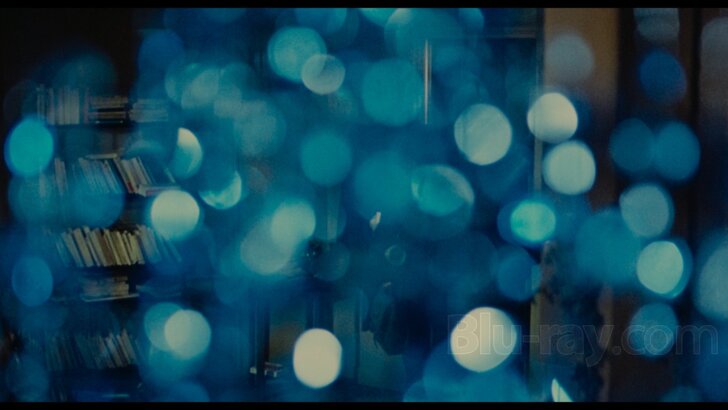
The new 4K makeover of Krzysztof Kieslowski's Blue has the exact same flaw the new 4K makeover of Peter Collinson's The Italian Job does. It greatly diminishes the very important role of the color blue and alters the original theatrical appearance of the film. This is unfortunate because a proper grading job would have ensured a definitive home video release of Blue. If you do not find the color modifications that are highlighted in our review important, then it is practically guaranteed that you will be very pleased with the overall quality of the 4K makeover. Blue is included in the Three Colors 4K Blu-ray/Blu-ray box set, which will be available for purchase next week.
UPDATE: I have received a market copy of the 4K Blu-ray/Blu-ray box set. The Blu-ray disc presents the older version of Blue, from the original three-disc Blu-ray box set, with the older color timing. So, if you purchase the 4K Blu-ray/Blu-ray box set, you will have the original presentation of Blue as well. Because of the inclusion of the older version of Blue, the overall score of our review has been updated.
Similar titles
Similar titles you might also like
(Still not reliable for this title)

Three Colors: Red 4K
Trois couleurs: Rouge
1994

Three Colors: White 4K
Trois couleurs: Blanc
1994

The Double Life of Véronique
La double vie de Véronique
1991

Vivre sa vie
Vivre sa vie: Film en douze tableaux / My Life to Live
1962

Belle de jour
1967

Dekalog
The Decalogue
1988

L' Avventura
1960

Sansho the Bailiff
山椒大夫 / Sanshô dayû
1954

Yi Yi
一一
2000

Red Desert
Il deserto rosso
1964

La Vie en Rose
2007

Breathless 4K
À bout de souffle
1960

The Red Shoes 4K
1948

Pather Panchali 4K
পথের পাঁচালী / Song of the Little Road
1955

Apur Sansar 4K
অপুর সংসার / The World of Apu
1959

Aparajito 4K
অপরাজিত / The Unvanquished
1956

Last Year at Marienbad
L'année dernière à Marienbad
1961

Paris, Texas
1984

24 Frames
2017

The Magician
Ansiktet
1958
